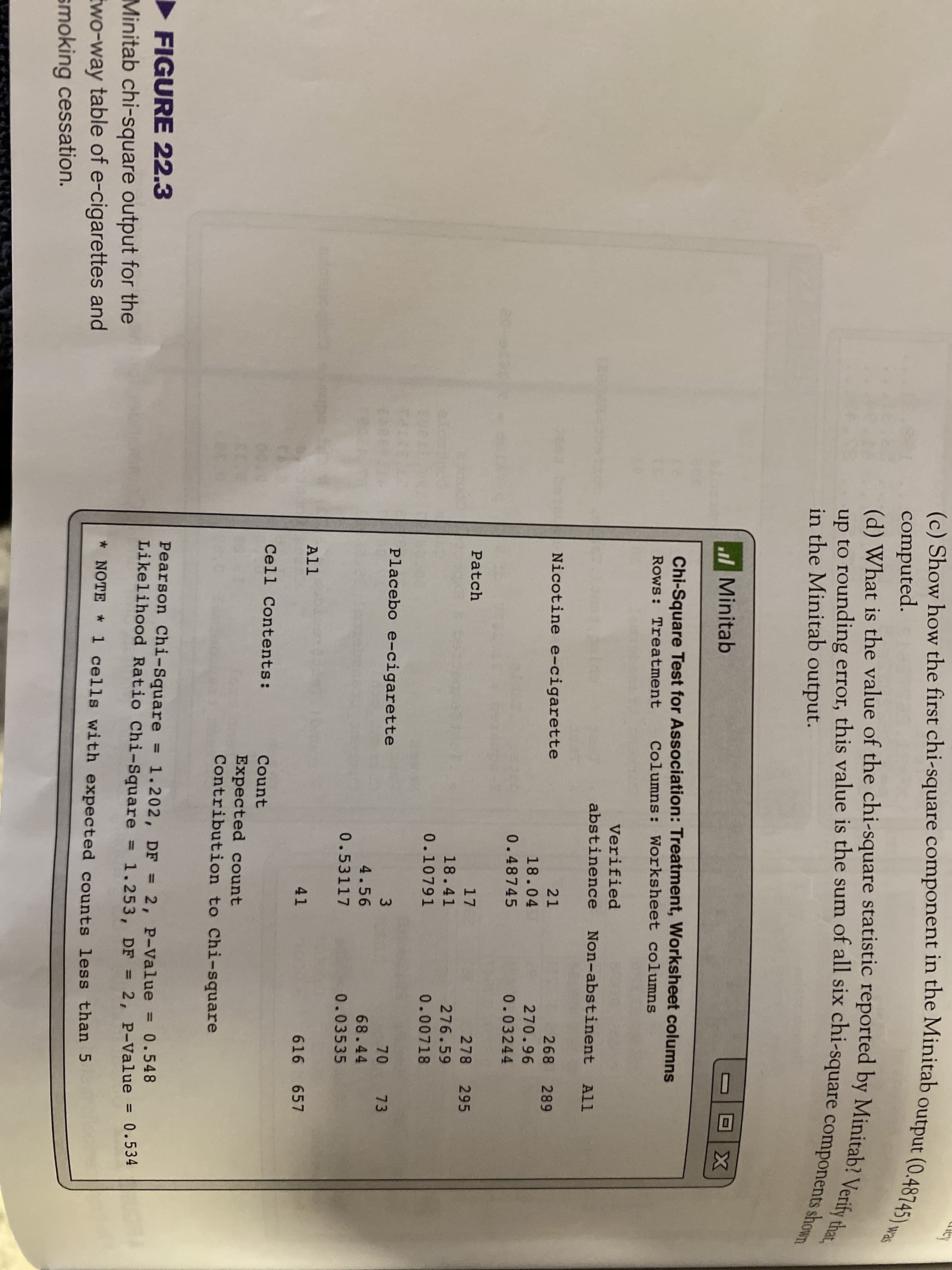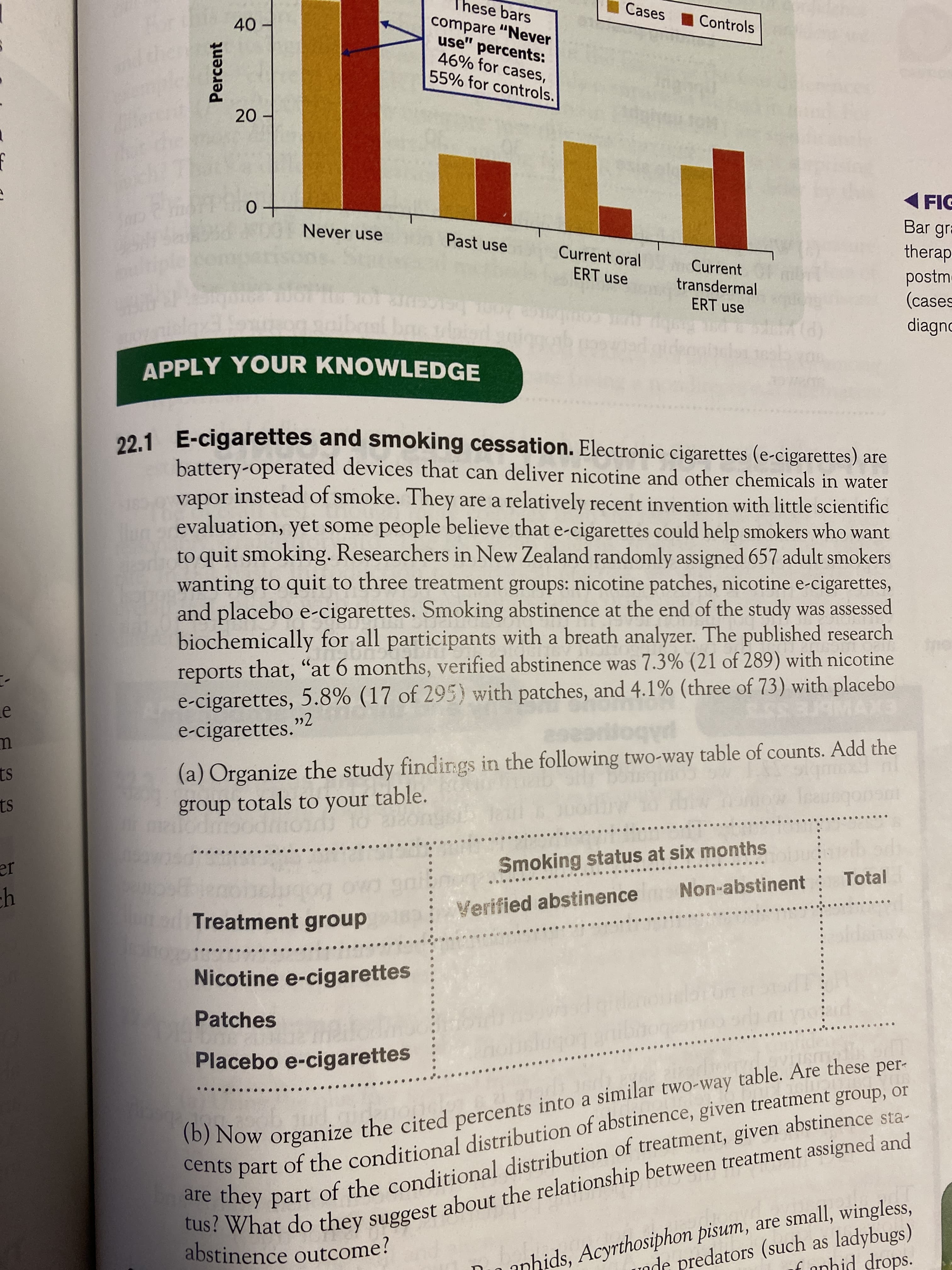Help with this, please! 22.7 E-cigarettes and smoking cessation, continued. Figure 22.3 shows the Minitab output for a chi-square test with a null hypothesis of no association between treatment received and abstinence outcome in the population of smokers who want to quit for the study first described in exercise 22.1. A) What is the P-value of the chi-square test? B) Explain why it doesn't make sense in this study to find the components that contribute the most to X2 or to closely examine how the observed counts differ from the expected counts. C) Conclude in the context of this problem.
Help with this, please! 22.7 E-cigarettes and smoking cessation, continued. Figure 22.3 shows the Minitab output for a chi-square test with a null hypothesis of no association between treatment received and abstinence outcome in the population of smokers who want to quit for the study first described in exercise 22.1. A) What is the P-value of the chi-square test? B) Explain why it doesn't make sense in this study to find the components that contribute the most to X2 or to closely examine how the observed counts differ from the expected counts. C) Conclude in the context of this problem.
Elements Of Modern Algebra
8th Edition
ISBN:9781285463230
Author:Gilbert, Linda, Jimmie
Publisher:Gilbert, Linda, Jimmie
Chapter2: The Integers
Section2.7: Introduction To Coding Theory (optional)
Problem 8E: Suppose the probability of incorrectly transmitting a single bit is . Compute the probability of...
Related questions
Question
Help with this, please!
22.7 E-cigarettes and smoking cessation, continued. Figure 22.3 shows the Minitab output for a chi-square test with a null hypothesis of no association between treatment received and abstinence outcome in the population of smokers who want to quit for the study first described in exercise 22.1.
A) What is the P-value of the chi-square test?
B) Explain why it doesn't make sense in this study to find the components that contribute the most to X2 or to closely examine how the observed counts differ from the expected counts.
C) Conclude in the context of this problem.

Transcribed Image Text:(c) Show how the first chi-square component in the Minitab
computed.
(d) What is the value of the chi-square statistic reported by Minitab! Verify that,
(c) Show how the first chi-square component in the Minitab output (0.48745) was
up to rounding error, this value is the sum of all six chi-square components shown
up to rounding error, this value is the sum of all six chi-square componene that,
in the Minitab output.
ulMinitab
Chi-Square Test for Association: Treatment, Worksheet columns
Rows: Treatment
Columns: Worksheet columns
Verified
abstinence Non-abstinent All
Nicotine e-cigarette
21
268 289
18.04
270.96
0.48745
0.03244
Patch
17
278
295
18.41
276.59
0.10791
0.00718
Placebo e-cigarette
3
70
73
4.56
68.44
0.53117
0.03535
All
41
616 657
Cell Contents:
Count
Expected count
Contribution to Chi-square
FIGURE 22.3
Pearson Chi-Square
1.202, DF = 2, P-Value = 0.548
%3D
%3D
Likelihood Ratio Chi-Square = 1.253, DF = 2, P-Value = 0.534
%3D
%3D
Minitab chi-square output for the
Ewo-way table of e-cigarettes and
smoking cessation.
* NOTE 1 cells with expected counts less than 5

Transcribed Image Text:40
20
Percent
tus? they the and
are they part of the of given sta-
(b) the into a similar two-way Are these p
These bars
compare "Never
use" percents:
46% for cases,
55% for controls.
Cases Controls
< FIG
Bar gra
Never use
Past use
therap
postm-
(cases
diagno
Current oral
Current
transdermal
ERT use
ERT use
(P)
22.1 E-cigarettes and smoking cessation. Electronic cigarettes (e-cigarettes) are
battery-operated devices that can deliver nicotine and other chemicals in water
vapor instead of smoke. They are a relatively recent invention with little scientific
evaluation, yet some people believe that e-cigarettes could help smokers who want
to quit smoking. Researchers in New Zealand randomly assigned 657 adult smokers
wanting to quit to three treatment groups: nicotine patches, nicotine e-cigarettes,
and placebo e-cigarettes. Smoking abstinence at the end of the study was assessed
biochemically for all participants with a breath analyzer. The published research
reports that, "at 6 months, verified abstinence was 7.3% (21 of 289) with nicotine
e-cigarettes, 5.8% (17 of 295) with patches, and 4.1% (three of 73) with placebo
e-cigarettes.
»2
MAX
(a) Organize the study findirgs in the following two-way table of counts. Add the
group totals to your table.
ts
ts
Smoking status at six months
Non-abstinent
..
Total
... .
Verified abstinence
Treatment group
Nicotine e-cigarettes
Patches
Now organize the cited percents into a similar two-way table. Are these per-
Cents part of the conditional distribution of abstinence, given treatment group, or
Placebo e-cigarettes
they part of the conditional distribution of treatment, given abstinence sta-
What do they suggest about the relationship between treatment assigned and
f onhid drops.
anhids, Acyrthosiphon pisum, are small, wingless,
1ode predators (such as ladybugs)
Expert Solution
This question has been solved!
Explore an expertly crafted, step-by-step solution for a thorough understanding of key concepts.
This is a popular solution!
Trending now
This is a popular solution!
Step by step
Solved in 3 steps

Recommended textbooks for you

Elements Of Modern Algebra
Algebra
ISBN:
9781285463230
Author:
Gilbert, Linda, Jimmie
Publisher:
Cengage Learning,

Algebra & Trigonometry with Analytic Geometry
Algebra
ISBN:
9781133382119
Author:
Swokowski
Publisher:
Cengage

Elements Of Modern Algebra
Algebra
ISBN:
9781285463230
Author:
Gilbert, Linda, Jimmie
Publisher:
Cengage Learning,

Algebra & Trigonometry with Analytic Geometry
Algebra
ISBN:
9781133382119
Author:
Swokowski
Publisher:
Cengage